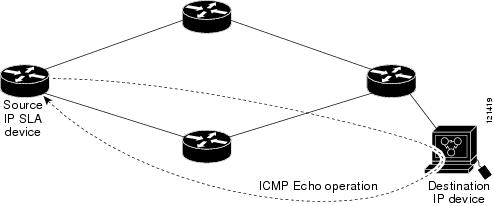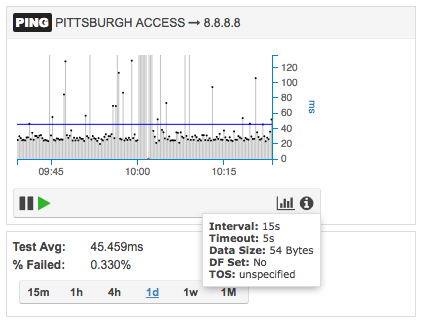If you are a network engineer, you are likely familiar with the Cisco IP Service Level Agreement (IP SLA) technology. In its basic operations, IP SLA enables routers to use the Internet Control Message Protocol (ICMP) and other protocols to monitor end-to-end response time between the router itself and an IP device, network service, and application. As stated in the Cisco IP SLA configuration guide, “IP SLAs uses active traffic monitoring—the generation of traffic in a continuous, reliable, and predictable manner—for measuring network performance”.

The following example shows how to configure a PING test with IP SLA with 15 sec. interval and 5 sec. of timeout:
ip sla monitor 6 type echo protocol ipIcmpEcho 8.8.8.8 source-ipaddr 10.0.0.1 frequency 15 request-data-size 54 timeout 5 ip sla monitor schedule 6 life forever start-time now
IP SLA not only permits the verification of connectivity and network performance of an IP infrastructure but also the monitoring and troubleshooting of application issues. For example, other protocols like DNS, HTTP, and Voice are available and can be used to verify DNS and HTTP response time or Mean Opinion Score (MOS). If you are looking to monitor application performance using IP SLA, one thing to keep in mind is that the source of the traffic shouldn’t be a router, but a real end-user device plugged into the access layer. Otherwise, the actual measurement and troubleshooting will lose visibility in the “last mile”. In this specific case, the last mile is the network portion between the router and the access layer where users connect.
To truly monitor and troubleshoot network and application performance issues from the user perspective, engineers have to run IP SLA tests from an end-user device.
Active Network Monitoring
The implementation of an active network monitoring solution like NetBeez allows you to run the same set of tests available in IP SLA but on an end-user device, generally a dedicated probe like the Raspberry Pi or an existing Linux workstation. This way, you can monitor the real end-to-end connectivity and performance between a client and a server, like an HTTP or DNS transaction, or between two clients, like it is the case for voice or video conferencing communications. When enough IP SLA sensors are installed in the network to provide proper coverage, network or application performance issues can be very easily detected and troubleshooted.

If you want to learn more about NetBeez, please check out the specs and features PDF, which gives an overview of the overall NetBeez system. Also, I would be happy to answer any questions you have, hear your feedback, or show you a demo of NetBeez at your convenience.





